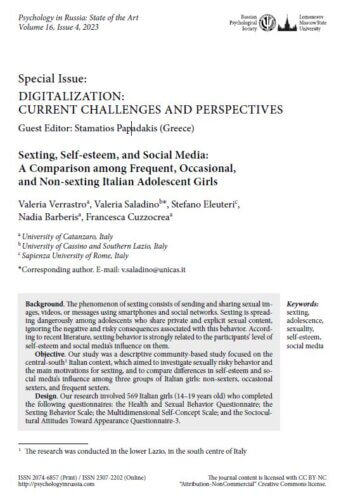Sexting
Sexting, Self-esteem, and Social Media: A Comparison among Frequent, Occasional, and Non-sexting Italian Adolescent Girls
Open Access: Yes.
Abstract
Introduction: The huge spread of the internet and especially of social media has led to new ways of communication, even erotic communication, especially among young people, replacing, in many cases, activities that until now required the face-to-face meeting of individuals.
Aim: To investigate the relationship between sexting and self-esteem, depression, anxiety, and stress among young people. Also, we investigated the impact of demographic characteristics on sexting.
Methods: A cross-sectional study was conducted with 368 young people aged 18-30 years old. We created an anonymous form of the study questionnaire with Google forms and we disseminated it through social media. Thus, we obtained a convenience sample. We used valid scales to measure sexting, self-esteem, depression, anxiety and stress among young people. All scales in our study had very good Cronbach’s alpha.
Results: Mean age of the participants was 23.7 years, while 82.3% was females. Mean every day time that participants spent on social media/platforms/applications was 4.7 hours. Participants used more often to communicate with others Instagram (86.8%) and Facebook (62.8%), and then Viber (29.9%), TikTok (9.8%), Snapchat (6%) and WhatsApp (5.1%). Frequency of texting was low among participants, while self-esteem level was average. Moreover, participants had higher levels of stress than depression and anxiety. We found that increased sexting was associated with decreased self-esteem (r=-0.3, p=0.02), increased depression (r=0.4, p=0.001), increased anxiety (r=0.3, p=0.005), and increased stress (r=0.4, p<0.001). Multivariable linear regression analysis identified that increased number of accounts on social media/platforms/applications (coefficient beta=0.07, 95% confidence interval=0.01 to 0.13, p-value=0.023) and increased age (coefficient beta=0.08, 95% confidence interval=0.01 to 0.13, p-value=0.003) was associated with increased sexting.
Conclusions: Understanding the relationship between sexting and self-esteem, depression, anxiety, and stress in young people will give policy makers the opportunity to develop appropriate health education programmes to reduce risky sexual behaviors.
Relevance
The study found that “most of the [adolescent] participants who sexted had had sexual intercourse (57.5%) and did not use contraceptive methods (56.4%).
Frequent sexters showed “higher levels” of the influence of social media on the internalization of the body and beauty images proposed by social media…and the perception of the media as a credible and essential source of information regarding fashion and beauty.”
“Frequent sexters showed lower global self-esteem.”
Citation
Verrastro, V., Saladino, V., Eleuteri, S., Barberis, N., & Cuzzocrea, F. (2023). Sexting, Self-esteem, and Social Media: A Comparison among Frequent, Occasional, and Non-sexting Italian Adolescent Girls. Psychology in Russia, 16(4), 3–20. https://doi.org/10.11621/pir.2023.0401

